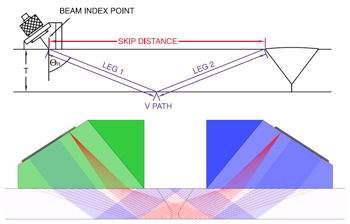In this second post of our three-part ECNDT 2018 wrap up series, learn about all the interesting presentations that our NDT experts gave at ECNDT. Check out the presentations below!
Phased Array Scan Planning and Modeling for Weld Inspection
Presenter: Thierry Couturier
Abstract
For the inspection of welds, phased array ultrasonic technology offers advantages in detection capabilities, interpretation, and flexibility. The technology can be used as a manual technique or in automated systems as a replacement for radiography. Codes governing the use of phased technology have been released, resulting in the wide adoption of the technology. All the codes require that users build a scan plan and describe the associated parameters, but none of the codes explain how to build a scan plan.
In this paper, I propose a scan plan methodology based on an example. Different codes are illustrated (EN13588, API 1104, ASME CC2235), and the example first considers the typical indications that must be detected in a weld before reviewing other variables, including:
The technical content of the paper can help level 2 and level 3 experts to better understand how phased array technology works and how the essential variables can be put together to build a good scan plan. |  Figure 1. Scan plan example for weld inspection with phased array technology |
In-Service Corrosion Mapping—Challenges for the Chemical Industry
Presenters: Florin Turcu, Timon Jedamski (Evonik Technology and Infrastructure), and Dirk Treppmann (Evonik Technology and Infrastructure)
Abstract
A typical chemical plant represents a challenge for asset condition monitoring with regards to wall thinning and corrosion. The conditions found in a chemical plant, such as elevated process temperatures, phase separations, flow dynamics, and variations in metallographic properties, make corrosion development and dynamics highly unpredictable.
Maintenance is usually performed at regular intervals within a limited time frame and includes both integrity assessment and repair. Interrupting normal activity for maintenance has huge costs to the plant operator, while the lack of predictability of the corrosion process can lead to wall thinning with consequences like vessel implosion or product leaking into the environment.
In-service inspection in these cases can help avoid accidents and minimize downtime for inspection. Industry requirements for in-service inspection include a high probability of detection (POD) of isolated pits, high sensitivity, and good near-surface resolution for the detection of severe wall-loss areas along with high-temperature capabilities. Some of these demands, including near-surface resolution and good sensitivity, can usually be accomplished by spot-testing with thickness gages while high POD can be achieved using ultrasonic phased array technology.
This paper will discuss general corrosion mapping challenges and focus on specific problems that arise during high-temperature inspection with phased array including suitable probes and wedges, coupling, and inspection methodology.
Improved Inspection of Composite Wind Turbine Blades with Advanced Ultrasonic Phased Array Technology
Presenter: André Lamarre
Abstract
In-service wind turbine blades are subjected to high levels of stress. Consequently, the bonding between the blade’s structural beams and shell must be characterized during manufacturing to help ensure blade integrity. The blades should also be clear of defects, like delamination and wrinkles. The material used to construct wind blades, such as fiberglass and carbon-reinforced plastics (CRP), pose particular challenges to ultrasonic inspection, and the industry has been searching for a simple and reliable solution. Olympus manufactures a variety of tools that make it easier to detect and size flaws in different areas of the blades. These tools include low-frequency linear phased array probes and probe holders combined with off-the-shelf ultrasonic phased array instruments and software bundled in a convenient, easy-to-use package. The advantages of using phased array include the fast inspection speed, small resolution, and full coverage of the inspected area. This paper illustrates how advanced ultrasonic phased array technology contributes to the improved integrity of composite wind turbine blades during manufacturing.
Coherent Adaptive Focusing Technology for the Inspection of Complex Geometry
Presenter: Etienne Grondin
Abstract
For the past several years, the aviation industry has seen above normal growth due, in part, to lower oil prices, saving major aircraft operators millions of dollars. As a result of this growth, production rates for new airplanes have increased, and new aircraft programs are being launched. Consequently, aviation component manufacturers are facing new challenges, including a rise in production rates, a high probability of detection (POD) due to the critical nature of the parts being manufactured, lack of skilled operators, and parts with increasingly complex geometry. Ultrasonic phased array (PA) instruments have evolved, enabling the implementation of advanced acquisition strategies. The introduction of these acquisition strategies helps manufacturers address the inspection challenges they are facing. The evolution of electronic components enables advanced acquisition strategies, such as adaptive focusing, to be implemented. Adaptive focusing simplifies the inspection of variable radiuses, variable opening angle, and twisted components, and will also compensate for probe misalignment by using innovative signal-processing algorithms. This paper presents an overview of the adaptive focusing technology with the goal of helping NDT integrators and composite material manufacturers to address the challenges they are facing in terms of system performance, production output, and quality control.
Related Content
Video: Advances in Phased Array Scan Plan Design Using the Compound S-Scan
5 Advantages Pipecheck Analyze Software Brings to Routine Corrosion Monitoring
Frustrated by Inspections That Are Out of Reach?
Get In Touch
